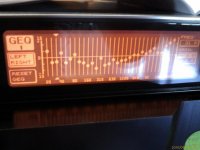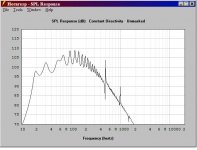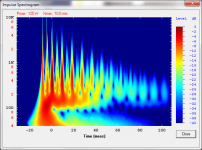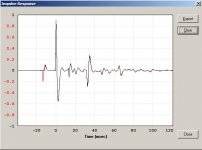It is impossible to change Pmax and Xmax for all older projects. The Maximum SPL window never shows "Press Ctrl+S to save new data" only "Enter a blank for normal SPL response"
Hi jogi59,
Changes cannot be saved to default record 1. For all other records the "Press Ctrl+S to save new data" message is displayed when the value in either of the input boxes is changed.
Could you please provide further information if this is not happening. Thanks.
Kind regards,
David
When looking over a simulation for a tapped horn w/ throat chamber I noticed that the impulse response graph showed pronounced differences with only minute changes in the length of the throat chamber coupling duct.
Also, you may notice how hard it is to see the red line in the comparison graphs.
Hi Oliver,
I found the problem - I had inadvertently omitted a small section of Jean-Michel's code. The error will be corrected in the next release. Many thanks for identifying this rather serious oversight - your ongoing 'debugging' contributions are very much appreciated!
Also, the impulse response compare trace will be changed from light red to red, to make it easier to see.
Kind regards,
David
Scenario 1:
Step 3 - Re-run impulse response tool - 1 second
Step 4 - Re-run spectrogram tool - 2 seconds
Scenario 2:
Step 3 - Re-run spectrogram tool - 2 seconds
Step 4 - Re-run impulse response tool - 1 second
The functionality has been further refined - in the next release, if either the impulse response tool or the spectrogram tool is re-run without any changes to the input parameter values, the results will be re-displayed with no perceptible delay.
Kind regards,
David
Hi Don,
Can you provide some more details? Thanks.
Kind regards,
David
David,
False alarm - I didn't understand how to use it properly.
hi David I have some good news.
I just presented a front loaded horn design at the DIY Ottawa meet. The good news is that it meets specs exactly as modeled. Actualy perfectly as modeled. I will do some exaustive testing to see wether it models the same electrically but acoustically it is spot on.
I did take great pains to make the folded version as cloase to the model as possible that is the hardest part of a good horn design. But I'm so happy that your program consistently pops out correct simulations if you take the time to make the real life design follow the modeled design.
http://www.diyaudio.com/forums/subw...-front-loaded-horn-subwoofer.html#post2222328
Mark
I just presented a front loaded horn design at the DIY Ottawa meet. The good news is that it meets specs exactly as modeled. Actualy perfectly as modeled. I will do some exaustive testing to see wether it models the same electrically but acoustically it is spot on.
I did take great pains to make the folded version as cloase to the model as possible that is the hardest part of a good horn design. But I'm so happy that your program consistently pops out correct simulations if you take the time to make the real life design follow the modeled design.
http://www.diyaudio.com/forums/subw...-front-loaded-horn-subwoofer.html#post2222328
Mark
David,
False alarm - I didn't understand how to use it properly.
Hi Don,
Not a problem
Kind regards,
David
hi David I have some good news.
Hi Mark,
Good news indeed - many thanks for the feedback!
Kind regards,
David
Now I have a request for possible application.
Has anyone thought of being able to import AkaBak scripts? Or am I way to late on the bandwagon on this one?
I'm guessing there would be some difficulty in being able to model more than one driver at more than one location. I'm looking at modeling some unity type enclosures and seeing what they would do. But I'm leaning more and more to trusting Hornresp more than AkaBak.
Mark
Has anyone thought of being able to import AkaBak scripts? Or am I way to late on the bandwagon on this one?
I'm guessing there would be some difficulty in being able to model more than one driver at more than one location. I'm looking at modeling some unity type enclosures and seeing what they would do. But I'm leaning more and more to trusting Hornresp more than AkaBak.
Mark
Hi Mark,
Sorry, but that is not going to happen .
.
There is nothing wrong with AkAbak provided that the limitations of the software are clearly understood. See my Post #1099 for further details.
Kind regards,
David
Has anyone thought of being able to import AkaBak scripts?
Sorry, but that is not going to happen
But I'm leaning more and more to trusting Hornresp more than AkaBak.
There is nothing wrong with AkAbak provided that the limitations of the software are clearly understood. See my Post #1099 for further details.
Kind regards,
David
Hornresp Version 27.10
Hi Everyone,
Hornresp Version 27.10 has just been released. Changes are:
1. The impulse response and spectrogram tools have been significantly improved thanks to new code provided by Jean-Michel. Not only are run times faster, but results are now more accurate.
2. Impulse response and spectrogram results are displayed instantly when the tools are re-run with unchanged input parameter values.
3. The impulse response compare trace has been changed from light red to red to make it easier to see, as suggested by Oliver in Post #1249.
4. The Loudspeaker Wizard now works with Vtc values up to 999999.9.
5. The impulse response bug reported by Oliver in Post #1249 has been fixed.
Kind regards,
David
Hi Everyone,
Hornresp Version 27.10 has just been released. Changes are:
1. The impulse response and spectrogram tools have been significantly improved thanks to new code provided by Jean-Michel. Not only are run times faster, but results are now more accurate.
2. Impulse response and spectrogram results are displayed instantly when the tools are re-run with unchanged input parameter values.
3. The impulse response compare trace has been changed from light red to red to make it easier to see, as suggested by Oliver in Post #1249.
4. The Loudspeaker Wizard now works with Vtc values up to 999999.9.
5. The impulse response bug reported by Oliver in Post #1249 has been fixed.
Kind regards,
David
Hi David,
that's nice not to have to wait for the calculation every time.
Here is the spectrogram of same box which I posted before.
http://www.diyaudio.com/forums/subwoofers/119854-hornresp-123.html#post2217369
that's nice not to have to wait for the calculation every time.
Here is the spectrogram of same box which I posted before.

http://www.diyaudio.com/forums/subwoofers/119854-hornresp-123.html#post2217369
Attachments
Last edited:
Here is the spectrogram of same box which I posted before.
Thanks vadi.
As you can see, there is more detail in the spectrogram generated using Jean-Michel's latest code.
Kind regards,
David
Impulse Response - Post #1249
Hi David,
Thanks to you and Jean-Michel for the quick fix (Post #1249), and the color change. There seems to still be something minor amiss with the impulse response tool, even though it is very much improved. Please, see attached impulse response comparison, same simulation as before, Lpt changed from 1.78 to 1.79cm.
Regards,
Hi David,
Thanks to you and Jean-Michel for the quick fix (Post #1249), and the color change. There seems to still be something minor amiss with the impulse response tool, even though it is very much improved. Please, see attached impulse response comparison, same simulation as before, Lpt changed from 1.78 to 1.79cm.
Regards,
Attachments
There seems to still be something minor amiss with the impulse response tool, even though it is very much improved. Please, see attached impulse response comparison, same simulation as before, Lpt changed from 1.78 to 1.79cm.
Hi Oliver,
Many thanks for this.
In my testing I had only compared Lpt = 1.78 against Lpt = 1.82, and because the results were almost the same I had assumed that the problem was fixed. I think this is probably one for Jean-Michel to look at. He is currently unavailable, but I will try to contact him early next week.
Kind regards,
David
Last edited:
Post #1276 - Impulse Response
Hi David,
I have seen similar simulation artifacts with changes of the Vtc in tapped horn simulations using a throat chamber, it seems that the last update fixed that problem, but should I come across another one I'll let you know.
It would be great if you or Jean-Michel could shed a little light on the nature of the negative time impulse response stemming from the Fourier transform of the SPL response. I have a foggy idea of this having something to do with the distortion products, and the mathematics of the transform, but never got any further than that. Anything in layman's terms, or reference sources, will be appreciated.
Thanks again for the continuing effort.
Regards,
Hi David,
I have seen similar simulation artifacts with changes of the Vtc in tapped horn simulations using a throat chamber, it seems that the last update fixed that problem, but should I come across another one I'll let you know.
It would be great if you or Jean-Michel could shed a little light on the nature of the negative time impulse response stemming from the Fourier transform of the SPL response. I have a foggy idea of this having something to do with the distortion products, and the mathematics of the transform, but never got any further than that. Anything in layman's terms, or reference sources, will be appreciated.
Thanks again for the continuing effort.
Regards,
When using Hornresp to simulate a horn with a vented rear chamber, does the port length include any end correction?
Hi Ian,
The Hornresp simulation model does not require an end correction as such. The so-called 'end effect' is already taken into account in the way that the acoustical impedance is calculated (the port tube is rigorously modelled as a cylindrical horn - no simplifying end correction assumptions are necessary).
Kind regards,
David
Hi Oliver,
Thanks.
Jean-Michel is the resident expert on such matters . Hopefully he should be back online early next week...
. Hopefully he should be back online early next week...
Kind regards,
David
I have seen similar simulation artifacts with changes of the Vtc in tapped horn simulations using a throat chamber, it seems that the last update fixed that problem, but should I come across another one I'll let you know.
Thanks.
It would be great if you or Jean-Michel could shed a little light on the nature of the negative time impulse response stemming from the Fourier transform of the SPL response.
Jean-Michel is the resident expert on such matters
Kind regards,
David
- Home
- Loudspeakers
- Subwoofers
- Hornresp



